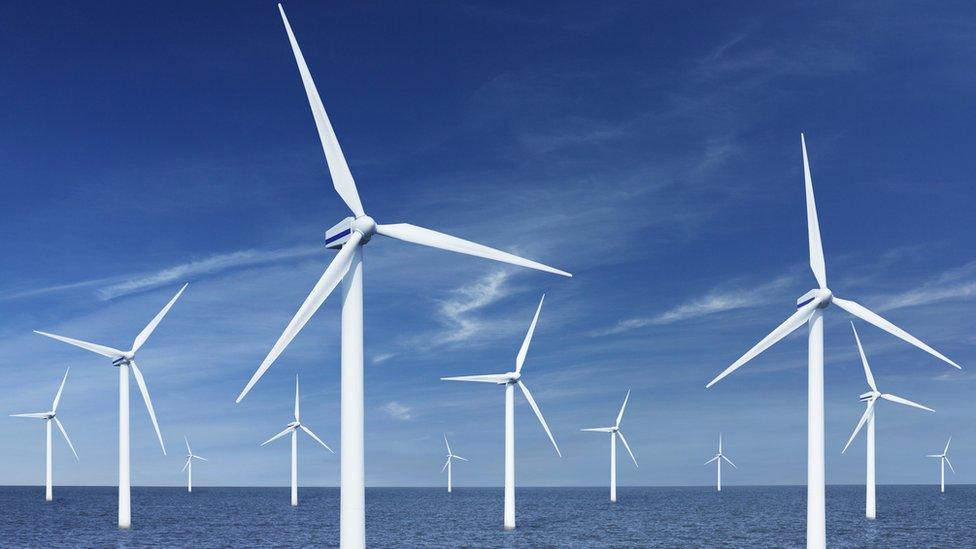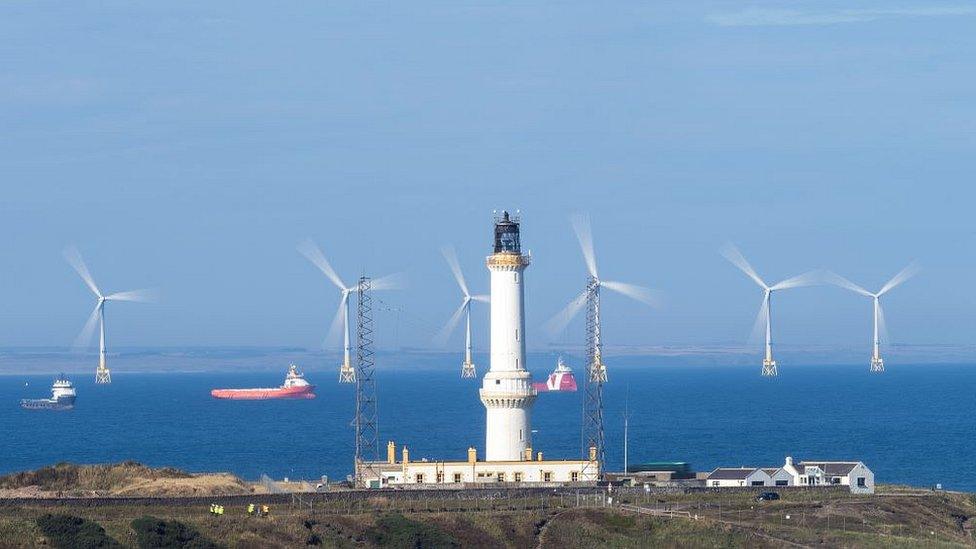Seabed power grid to link North Sea wind turbines
- Published

A vast power grid on the seabed of the central North Sea is being planned as part of a £20bn project to power oil and gas platforms with green electricity.
Cerulean Winds won the rights to develop projects aimed at reducing the use of gas by offshore installations.
It aims to link more than 400 offshore turbines with the high voltage cables.
The company says the plan will involve 10,000 jobs, many of which could be in the supply chain in Scotland.
It hopes to have the infrastructure in place by 2028.
Dan Jackson, chief executive of the developer, said Scotland was among the most investable countries in the world for floating wind farms.
His company has formed a consortium of partners with experience in the sector, including NOV, Siemens Gamesa, Siemens Energy, DEME and Worley.
Hundreds of turbines are due to be installed in the next ten years in 20 sea areas included in the ScotWind round of developments, some of them fixed to the seabed and some anchored to it with cables.
ScotWind will link to the onshore National Grid. Energy firms have paid £755m to Crown Estates Scotland, which duly passes the funds to the Scottish government, for the rights to develop.
The Cerulean Winds project for an offshore subsea grid is part of another round called Innovation and Targeted Oil and Gas (Intog), which covers an element of innovation in technology but mostly provides renewable power to oil and gas installations to reduce their use of gas to power their operations.

Instead of a series of direct cables between turbines and platforms, the subsea grid is intended to provide reliability and flexibility of power supply.
Mr Jackson said the priority was to build wind capacity for the oil and gas sector as fast as possible, and as it grows, then to use it to provide power over long-distance high voltage direct current subsea cables for onshore supply throughout Britain and for export.
The plan is for three connected large sea areas in the central North Sea covering nearly 400 square miles (1,000 square km).
"Early oil and gas electrification supports the country's energy security, net-zero action and delivers huge benefits to the supply chain and economy, creating 10,000 jobs," he said.
"With our partners we will accelerate access to green power and provide the infrastructure for the next phase of the North Sea's life."
'Build with urgency'
He told BBC Scotland: "We're comfortably in excess ultimately of 300 or 400 turbines. That's built out in phases, and in the first phase for the oil and gas demands.
"We have to build these out with urgency to give oil and gas green energy as quickly as we can, with flexibility and reliability."
He said the sites would be "stepping stones" to building larger scale floating wind farms.
Mr Jackson added: "What we've been waiting for in Scotland, and particularly those ports and yards which have been suffering with the decline of the oil and gas industry, is for renewables to take off. That is now happening.
"Scotland's supply chain base is there. When I say Scotland is now one of the best investable countries in the world for large scale infrastructure in green energy, one of the key reasons is that the supply chain base is there from its 50 year history in oil and gas."

There is vast potential in offshore wind, now that floating turbines are proving their potential when anchored in deep water.
It is reckoned that nearly a third of the world's current order pipeline for floating wind is destined for Scottish waters.
As the first place in the world to have a floating wind farm, and lots more to come, Scottish industry has an opportunity for the distinct requirements of floating wind turbines to become a specialism of Scottish suppliers.
The new plan for a North Sea subsea power grid of cables could be an important step towards co-ordinating this effort.
To become reality, this requires joining up capacity with orders, though some investment is waiting for the orders before capacity can be built. There are concerns that Scotland is not geared up to handle the scale of industrial manufacturing that is now a prospect.
Those concerns extend to rising prices where the supply chain is unable to meet demand, when steel and wages are among costs also challenging the finances, and when the UK government has set its sights on continued sharp reductions in the cost at which offshore wind can provide for onshore customers.
This requires a lot of joining up the different elements of this pipeline of huge engineering projects ,from governments and their agencies, the industry and the public to accept big port developments.